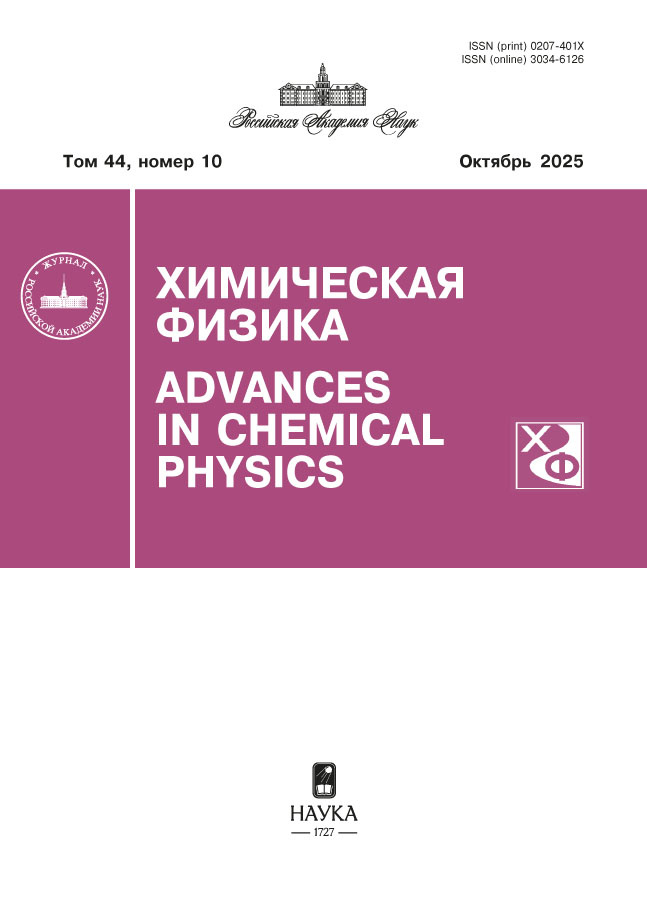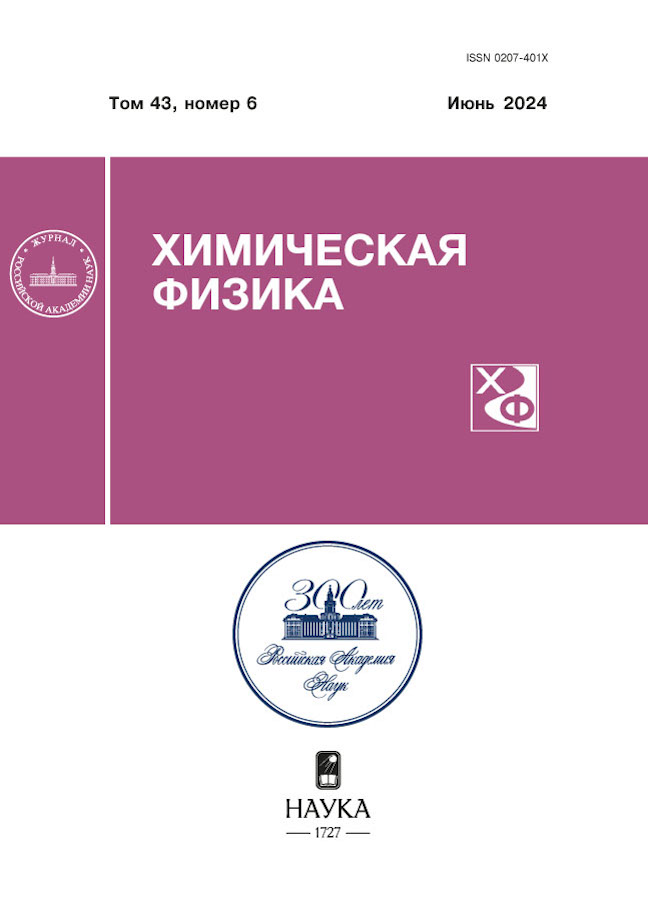Том 43, № 6 (2024)
Элементарные физико-химические процессы
Реакция атомарного фтора с бензолом
Аннотация
Бензол относится к одному из наиболее распространенных в промышленности классов химических веществ. Как правило, в атмосферу он попадает в основном вследствие техногенных аварий, а также при испарении растворителей. Бензол и его производные токсичны и негативно влияют на окружающую среду и организм человека. Поэтому вопросы трансформации бензола в атмосфере представляют повышенный интерес. В настоящей работе методом функционала плотности рассчитаны структуры и электронные энергии равновесных конфигураций и переходных комплексов систем C₆H₆ F и C₆H₆F⁺. Показано, что взаимодействие бензола с атомарным фтором может протекать по двум каналам: отщепление водорода с образованием фенил-радикала и присоединение атома фтора с образованием ипсо-фторциклогексадиенил-радикала. Установлено, что для диссоциации ипсо-фторциклогексадиенил-радикала на фторбензол и атомарный водород необходимо затратить около 27 ккал/моль. Это указывает на малую вероятность протекания этого процесса при низких температурах. В условиях эксперимента, когда температура атомов фтора составляет около 1000 K, происходит распад ипсо-фторциклогексадиенил-радикала с образованием фторбензола. При этом протекание вторичных реакций маловероятно. Выводы, сделанные на основе анализа результатов квантовохимических расчетов, хорошо согласуются с экспериментальными данными.
 3-15
3-15


Кинетика и механизм химических реакций, катализ
Гетерогенная реакция диметилсульфида с атомом хлора
Аннотация
Методом резонансной флуоресценции атомов хлора измерена константа скорости реакции атома хлора с диметилсульфидом (ДМС) в диапазоне температур 308–366 K. Показано, что константа скорости реакции уменьшается при проведении экспериментов при более высокой температуре. При температуре 308 K проведены измерения константы скорости данной реакции при разных соотношениях времен реакции и диффузии атомов хлора к стенке реактора. Данные этих экспериментов показали, что при увеличении времени диффузии активных центров к поверхности реактора по сравнению со временем контакта реагентов, наблюдается уменьшение измеряемого значения константы скорости реакции. Это позволило утверждать, что реакция является гетерогенной и взаимодействие атома хлора с ДМС происходит на поверхности реактора.
 16-24
16-24


Горение, взрыв и ударные волны
Измерение концентрации электронов в окрестности сильной ударной волны
Аннотация
Проведена серия зондовых измерений по определению концентрации электронов в газе перед фронтом сильной ударной волны с использованием двухдиафрагменной ударной трубы DDST-M (modified double-diaphragm shock tube) Института механики МГУ. Одновременно фиксировался световой поток из области ударно-нагретого газа, который позволил вычислить концентрацию электронов за ударной волной с помощью спектроскопического метода. Эксперименты выполнены в воздухе, кислороде и азоте при скоростях ударной волны от 8.3 до 11.3 км/с и начальном давлении в камере низкого давления 0.25 Торр. Получены зависимости концентрации электронов от скорости ударной волны и расстояния от точки наблюдения до ударной волны. Спектроскопические измерения позволили определить зависимость концентрации электронов от состава газовой среды. Полученные данные сравниваются с экспериментальными результатами других авторов.
 25-32
25-32


Спектральная модель для расчета радиационных характеристик ударно-нагретого газа
Аннотация
Представлена расширенная версия разработанной ранее вычислительной процедуры SPECTRUM, которая позволяет рассчитывать радиационные характеристики ударно-нагретого газа с учетом снижения интенсивности излучения в поглощающей среде. Процедура базируется на полинейном (line-by-line) расчете спектров излучения и поглощения атомов и молекул, входящих в состав исследуемой газовой смеси. При вычислении спектров излучения атомов и молекул значения спектроскопических констант брались из известных баз данных. Проведено сравнение результатов расчета интегральных по времени спектральных характеристик ударно-нагретого воздуха с имеющимися экспериментальными данными, полученными в ультрафиолетовой, видимой и инфракрасной областях спектра.
 33-40
33-40


Химическая физика экологических процессов
Оценка выбросов металлургических предприятий методом инфракрасной фурье-спектроскопии
Аннотация
Ежегодно металлургические предприятия выбрасывают в атмосферу сотни тысяч тонн вредных веществ. Дистанционный мониторинг отходящих газов дымовых труб металлургических комплексов является актуальной задачей как для самих промышленных предприятий, так и систем экологического контроля близлежащих населенных пунктов. В настоящей работе на основе результатов дистанционного оптического мониторинга выбросов дымовых труб металлургических заводов Заполярного филиала ГМК “Норильский никель” проведена оценка концентрации диоксида серы в отходящих газах. Измерения проводились с использованием инфракрасных фурье-спектрометров, работающих в диапазоне длин волн 7–13 мкм со спектральным разрешением 4 см⁻¹. Предложена новая технология дистанционного оптического зондирования в пассивном режиме отходящих газов металлургических предприятий, включающая измерения как на срезах дымовых труб, так и на шлейфах.
 41-52
41-52


Химическая физика атмосферных явлений
Механизм захвата O₃ на компоненте MgCl₂ · 6H₂O морской соли
Аннотация
Исследован захват O₃ на компоненте MgCl₂ · 6H₂O морской соли при T = 254 и 295 К в диапазоне [O₃] = 2.5 · 10¹³–1.6 · 10¹⁴ cм⁻³ с использованием проточного реактора с подвижной вставкой и масс-спектрометрической регистрации. Получена временна́я зависимость коэффициента захвата озона при различных концентрациях O₃ в диапазоне относительной влажности от нуля до 24%. Методом математического моделирования, исходя из формы зависимости коэффициента захвата и его временно́го спада от концентрации озона, установлен механизм захвата и сделана оценка элементарных кинетических параметров, на основании которых можно экстраполировать временно́е поведение коэффициента захвата к условиям тропосферы при произвольных концентрациях озона. Захват озона при комнатной температуре происходит по механизму реакции адсорбированной молекулы на поверхности субстрата. Механизм включает стадию обратимой адсорбции, образование адсорбированного комплекса и его последующий мономолекулярный распад с выходом в газовую фазу молекулярного хлора. При низких температурах захват протекает через рекомбинацию по реакционному механизму Или–Ридила: он включает в себя обратимую адсорбцию, образование поверхностного комплекса, его реакцию с молекулой озона из газовой фазы и выходом в газовую фазу молекулы кислорода. Образование хлора при этом не происходит. Зависимости коэффициента захвата от относительной влажности в диапазоне ее значений от 0 до 24% при Т = 254 К не обнаружено.
 53-63
53-63


Влияние частиц слоя юнге на длину цепи разрушения озона в атмосфере
Аннотация
В работе приводятся результаты расчетов длины цепей разрушения озона в нижней стратосфере в каталитических HOx-, NOx-, ClOx- циклах с учетом гетерогенных химических реакций (ГХР) с участием частиц слоя Юнге. Учет этих реакций приводит к изменению вида высотных профилей длины цепей в этих циклах, рассчитанных в приближении отсутствия ГХР. На нижней границе слоя Юнге наблюдается вырождение цепного разрушения озона в NOx-цикле, вызванное резким спадом концентраций компонентов этого семейства, обусловленным захватом газовых молекул N₂O₅. При этом наблюдается рост длины цепи в HOx-цикле более чем на порядок величины из-за снижения концентраций радикалов ОН и НО₂ и, как результат, спада скорости обрыва цепей с их участием. На бóльших высотах длины цепей разрушения озона с учетом ГХР, напротив, оказываются выше; сказывается ускорение разрушения O₃ переносчиками цепи в HOx- и ClOx-циклах. Рост их концентраций обусловлен пониженным содержанием в воздухе NO и NO₂. Рассматриваемое влияние ГХР практически исчезает на верхней границе слоя Юнге вследствие испарения частиц.
 64-71
64-71


Возмущение ионосферного электрического поля при повышении эманации радона
Аннотация
За счет повышения эманации радона увеличивается проводимость в приземном слое воздуха, что вызывает изменение электрического поля в нижней части атмосферы и, согласно некоторым гипотезам, в ионосфере. Известны предложения о возможности использовать такие ионосферные возмущения в качестве предвестников землетрясений. В представленной работе ионосферные электрические поля рассчитаны в рамках квазистационарной модели атмосферного проводника, включающего ионосферу. Также рассмотрены следствия кажущейся парадоксальной точки зрения об уменьшении проводимости приземного воздуха при повышении содержания радона. Показано, что даже при экстремальной эманации радона рассчитанные возмущения ионосферного электрического поля получаются на три-четыре порядка меньшими, чем предполагаемые предвестники землетрясений.
 72-80
72-80


Математическое моделирование возмущения атмосферного электрического поля во время геомагнитной бури 17 марта 2015 года
Аннотация
Из данных наблюдений следует, что во время геомагнитных бурь происходят изменения электрического поля в атмосфере. В представленной работе мы в рамках квазистационарной модели проводника, состоящего из атмосферы и ионосферы, рассчитываем ионосферные электрические поля в период главной фазы геомагнитной бури 17 марта 2015 г. При этом для описания магнитосферного источника электрического поля используются спутниковые данные о глобальном распределении токов между магнитосферой и ионосферой. Изменение электрического потенциала в ионосфере приводит к изменению электрического поля во всей атмосфере, включая ее приземный слой. Важно, что в период геомагнитной бури обсерватория, в которой измеряется атмосферное электрическое поле, существенно меняет свое положение относительно направления на Солнце. Это приводит к значительным изменениям ионосферной проводимости над обсерваторией, которые влияют как на ионосферное электрическое поле, так и на атмосферную часть глобальной электрической цепи. Из этого следует, что при оценке влияния геомагнитной бури на атмосферное электрическое поле в конкретной обсерватории необходимо учитывать местное время при сопоставлении данных измерений с индексами геомагнитной активности. Для бури 17–18 марта 2015 г. нами получено, что учет вариаций ионосферного электрического поля при расчете атмосферного электрического поля позволяет воспроизвести наблюдаемые в Геофизической обсерватории “Борок” возмущения электрического поля “хорошей” погоды. На основе результатов моделирования показано, что во время экстремально сильных магнитных бурь в некоторых местах на Земле формируются вариации того же масштаба, что и само поле “хорошей” погоды.
 81-90
81-90


Мультимодельное исследование влияния атмосферных волн от тропосферного источника на ионосферу во время геомагнитной бури 27–29 мая 2017 г.
Аннотация
Исследовано влияние атмосферных волн, генерируемых тропосферным конвективным источником, на состояние верхней атмосферы и ионосферы на фазе восстановления геомагнитной бури 27–28 мая 2017 года. Предложен и реализован новый подход к учету генерируемых тропосферными конвективными источниками атмосферных волн в крупномасштабных моделях атмосферы без использования их параметризации. Разработанный подход позволяет комплексно исследовать создаваемые атмосферными волнами эффекты на фоне различных геофизических событий, в том числе в условиях геомагнитной бури. Проведенное мультимодельное исследование показало, что предложенный подход позволяет воспроизвести возмущения критической частоты F₂-слоя ионосферы, вызванные распространением атмосферных волн, генерируемых тропосферным метеорологическим источником. Показано, что включение источника притока тепла, имитирующего распространение атмосферных волн из нижних слоев атмосферы, в глобальную модель усиливает эффекты геомагнитной бури, что проявляется в виде дополнительного понижения критической частоты F₂-слоя, которые могут достигать 7% от абсолютных значений.
 91-104
91-104


Статистический анализ возрастаний потоков энергичных электронов в низкоширотной ионосфере по данным спутников NOAA/POES и MetOp с 1998 по 2022 год
Аннотация
Интенсивные высыпания быстрых электронов из радиационного пояса Земли (РПЗ) являются одним из важнейших источников ионизации в ионосфере и атмосфере. В данной работе проведен масштабный статистический анализ данных непрерывных низкоорбитальных спутниковых наблюдений солнечно-циклической вариации возрастания интенсивности потоков электронов РПЗ с энергией Ee > 30 кэВ на высоте 850 км, полученных со спутников NOAA/POES и MetOp в период с 1998 по 2022 г. В ходе исследования установлен и подробно описан характер возможных технических сбоев в массивах данных спутниковых измерений с высоким временны́м разрешением, полученных с 2014 по 2022 г. Проведена соответствующая коррекция данных. Показано, что среднегодовое количество суток с возрастанием потоков энергичных электронов быстро увеличивается в течение трех лет после прохождения максимума солнечного цикла и достигает наибольших значений вблизи середины фазы спада солнечной активности. Затем частота событий начинает заметно уменьшаться на восьмилетнем интервале, который включает фазы минимума, роста и максимума солнечного цикла. Минимальный уровень достигается в максимуме солнечной активности.
 105-116
105-116













